EDF5020: Literature Review on Early Years Teaching Mathematics
VerifiedAdded on 2023/06/07
|11
|2620
|473
Report
AI Summary
This report presents a comprehensive literature review on early years teaching, focusing on the Australian mathematics curriculum, particularly in the areas of algebra and numbers. The review synthesizes information from six research-based publications, with an emphasis on articles published within ...
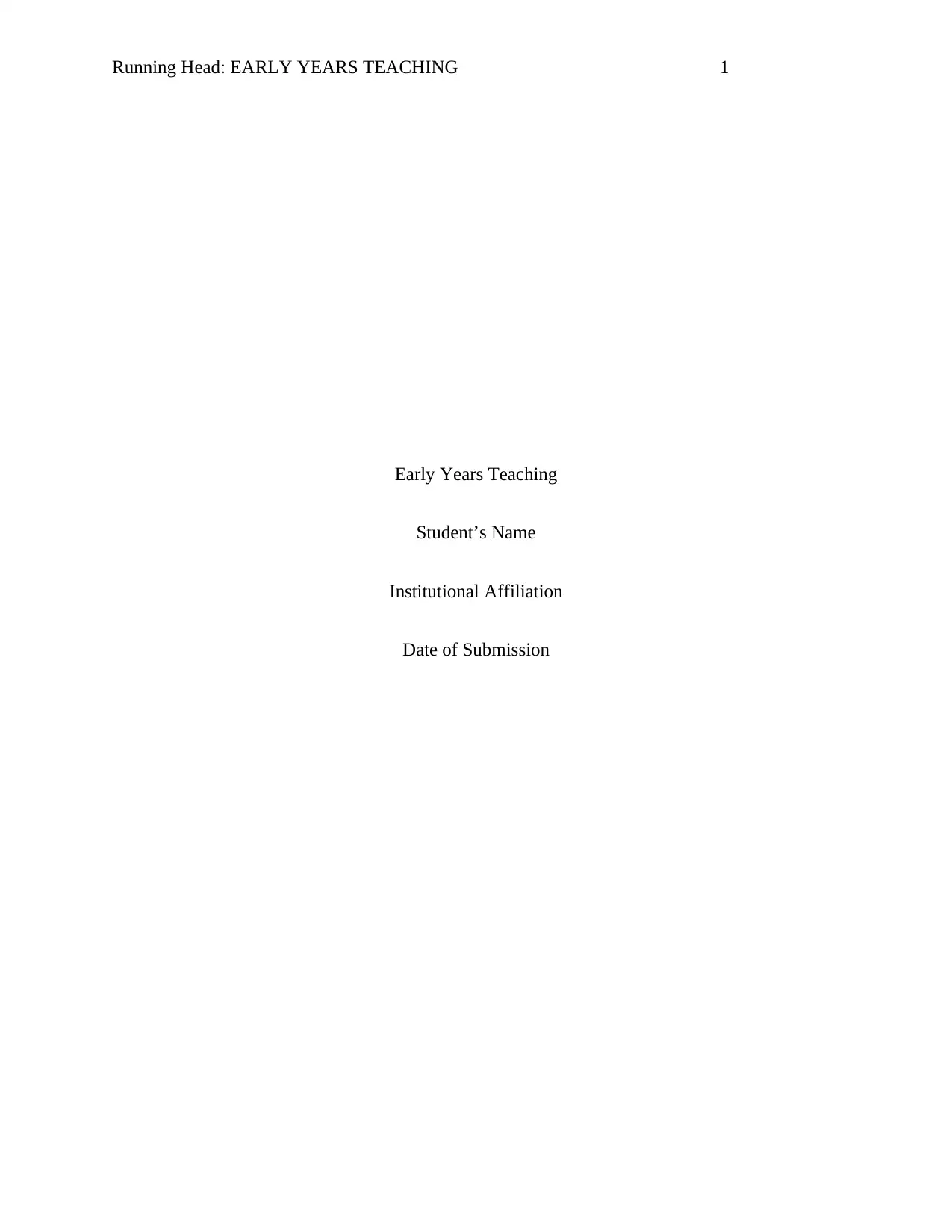
Running Head: EARLY YEARS TEACHING 1
Early Years Teaching
Student’s Name
Institutional Affiliation
Date of Submission
Early Years Teaching
Student’s Name
Institutional Affiliation
Date of Submission
Paraphrase This Document
Need a fresh take? Get an instant paraphrase of this document with our AI Paraphraser
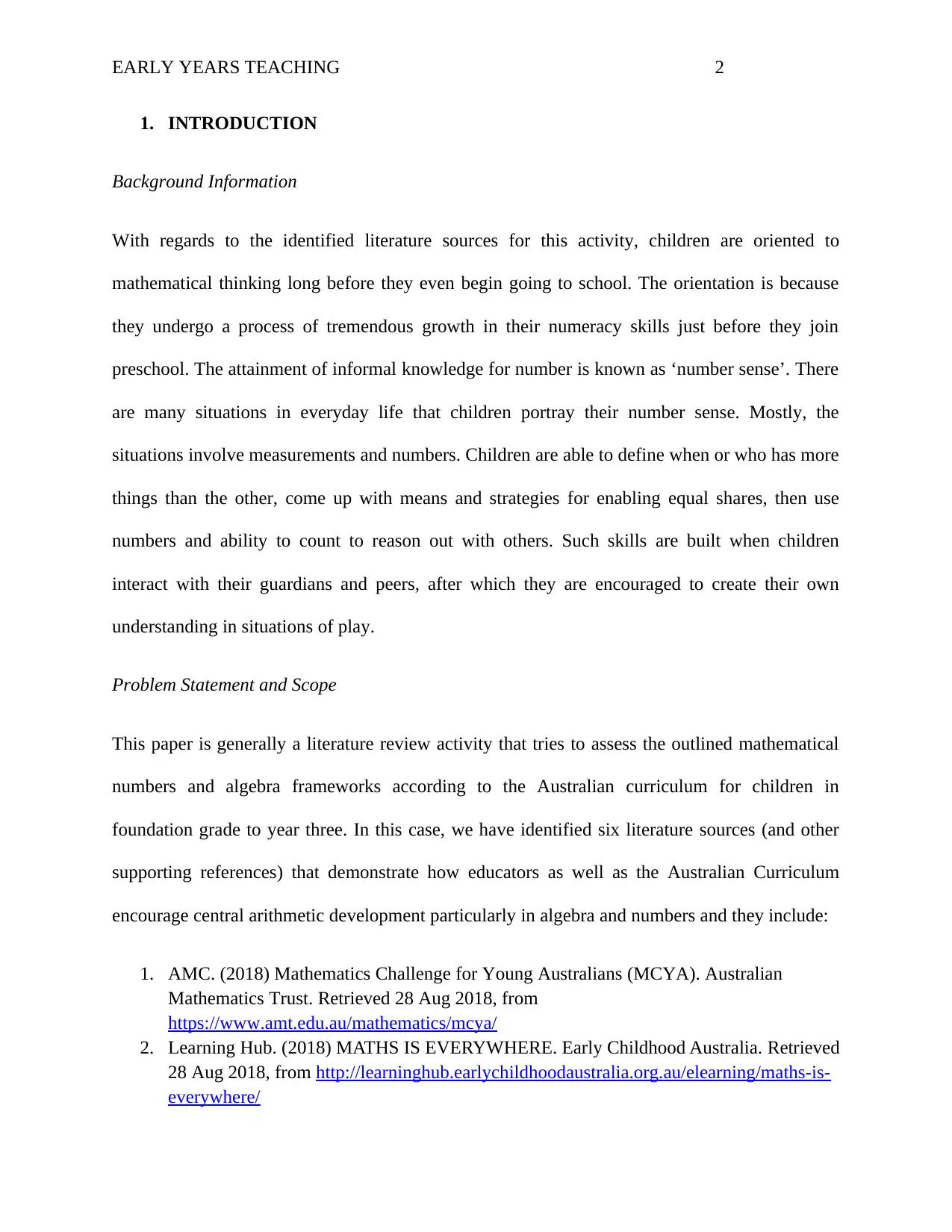
EARLY YEARS TEACHING 2
1. INTRODUCTION
Background Information
With regards to the identified literature sources for this activity, children are oriented to
mathematical thinking long before they even begin going to school. The orientation is because
they undergo a process of tremendous growth in their numeracy skills just before they join
preschool. The attainment of informal knowledge for number is known as ‘number sense’. There
are many situations in everyday life that children portray their number sense. Mostly, the
situations involve measurements and numbers. Children are able to define when or who has more
things than the other, come up with means and strategies for enabling equal shares, then use
numbers and ability to count to reason out with others. Such skills are built when children
interact with their guardians and peers, after which they are encouraged to create their own
understanding in situations of play.
Problem Statement and Scope
This paper is generally a literature review activity that tries to assess the outlined mathematical
numbers and algebra frameworks according to the Australian curriculum for children in
foundation grade to year three. In this case, we have identified six literature sources (and other
supporting references) that demonstrate how educators as well as the Australian Curriculum
encourage central arithmetic development particularly in algebra and numbers and they include:
1. AMC. (2018) Mathematics Challenge for Young Australians (MCYA). Australian
Mathematics Trust. Retrieved 28 Aug 2018, from
https://www.amt.edu.au/mathematics/mcya/
2. Learning Hub. (2018) MATHS IS EVERYWHERE. Early Childhood Australia. Retrieved
28 Aug 2018, from http://learninghub.earlychildhoodaustralia.org.au/elearning/maths-is-
everywhere/
1. INTRODUCTION
Background Information
With regards to the identified literature sources for this activity, children are oriented to
mathematical thinking long before they even begin going to school. The orientation is because
they undergo a process of tremendous growth in their numeracy skills just before they join
preschool. The attainment of informal knowledge for number is known as ‘number sense’. There
are many situations in everyday life that children portray their number sense. Mostly, the
situations involve measurements and numbers. Children are able to define when or who has more
things than the other, come up with means and strategies for enabling equal shares, then use
numbers and ability to count to reason out with others. Such skills are built when children
interact with their guardians and peers, after which they are encouraged to create their own
understanding in situations of play.
Problem Statement and Scope
This paper is generally a literature review activity that tries to assess the outlined mathematical
numbers and algebra frameworks according to the Australian curriculum for children in
foundation grade to year three. In this case, we have identified six literature sources (and other
supporting references) that demonstrate how educators as well as the Australian Curriculum
encourage central arithmetic development particularly in algebra and numbers and they include:
1. AMC. (2018) Mathematics Challenge for Young Australians (MCYA). Australian
Mathematics Trust. Retrieved 28 Aug 2018, from
https://www.amt.edu.au/mathematics/mcya/
2. Learning Hub. (2018) MATHS IS EVERYWHERE. Early Childhood Australia. Retrieved
28 Aug 2018, from http://learninghub.earlychildhoodaustralia.org.au/elearning/maths-is-
everywhere/
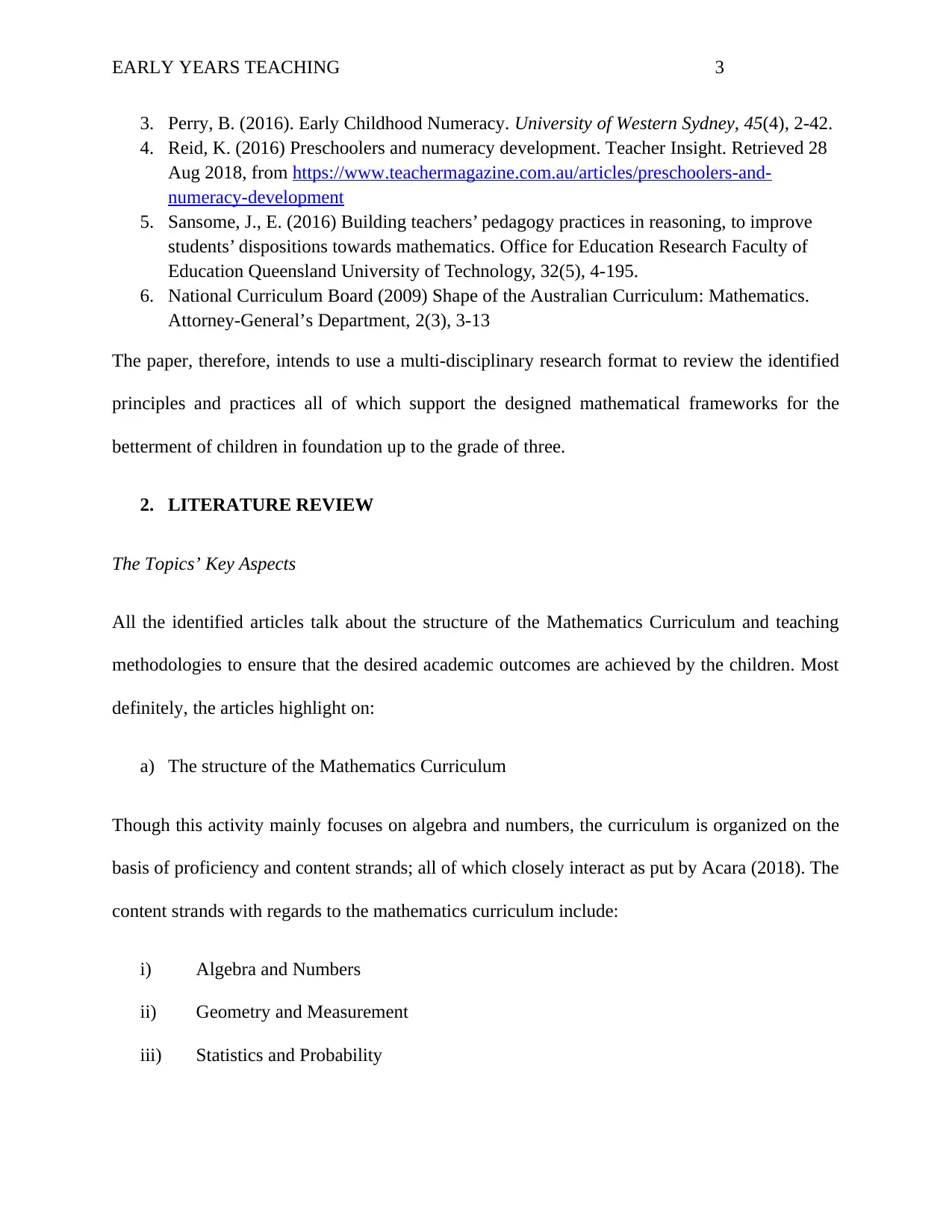
EARLY YEARS TEACHING 3
3. Perry, B. (2016). Early Childhood Numeracy. University of Western Sydney, 45(4), 2-42.
4. Reid, K. (2016) Preschoolers and numeracy development. Teacher Insight. Retrieved 28
Aug 2018, from https://www.teachermagazine.com.au/articles/preschoolers-and-
numeracy-development
5. Sansome, J., E. (2016) Building teachers’ pedagogy practices in reasoning, to improve
students’ dispositions towards mathematics. Office for Education Research Faculty of
Education Queensland University of Technology, 32(5), 4-195.
6. National Curriculum Board (2009) Shape of the Australian Curriculum: Mathematics.
Attorney-General’s Department, 2(3), 3-13
The paper, therefore, intends to use a multi-disciplinary research format to review the identified
principles and practices all of which support the designed mathematical frameworks for the
betterment of children in foundation up to the grade of three.
2. LITERATURE REVIEW
The Topics’ Key Aspects
All the identified articles talk about the structure of the Mathematics Curriculum and teaching
methodologies to ensure that the desired academic outcomes are achieved by the children. Most
definitely, the articles highlight on:
a) The structure of the Mathematics Curriculum
Though this activity mainly focuses on algebra and numbers, the curriculum is organized on the
basis of proficiency and content strands; all of which closely interact as put by Acara (2018). The
content strands with regards to the mathematics curriculum include:
i) Algebra and Numbers
ii) Geometry and Measurement
iii) Statistics and Probability
3. Perry, B. (2016). Early Childhood Numeracy. University of Western Sydney, 45(4), 2-42.
4. Reid, K. (2016) Preschoolers and numeracy development. Teacher Insight. Retrieved 28
Aug 2018, from https://www.teachermagazine.com.au/articles/preschoolers-and-
numeracy-development
5. Sansome, J., E. (2016) Building teachers’ pedagogy practices in reasoning, to improve
students’ dispositions towards mathematics. Office for Education Research Faculty of
Education Queensland University of Technology, 32(5), 4-195.
6. National Curriculum Board (2009) Shape of the Australian Curriculum: Mathematics.
Attorney-General’s Department, 2(3), 3-13
The paper, therefore, intends to use a multi-disciplinary research format to review the identified
principles and practices all of which support the designed mathematical frameworks for the
betterment of children in foundation up to the grade of three.
2. LITERATURE REVIEW
The Topics’ Key Aspects
All the identified articles talk about the structure of the Mathematics Curriculum and teaching
methodologies to ensure that the desired academic outcomes are achieved by the children. Most
definitely, the articles highlight on:
a) The structure of the Mathematics Curriculum
Though this activity mainly focuses on algebra and numbers, the curriculum is organized on the
basis of proficiency and content strands; all of which closely interact as put by Acara (2018). The
content strands with regards to the mathematics curriculum include:
i) Algebra and Numbers
ii) Geometry and Measurement
iii) Statistics and Probability
⊘ This is a preview!⊘
Do you want full access?
Subscribe today to unlock all pages.

Trusted by 1+ million students worldwide
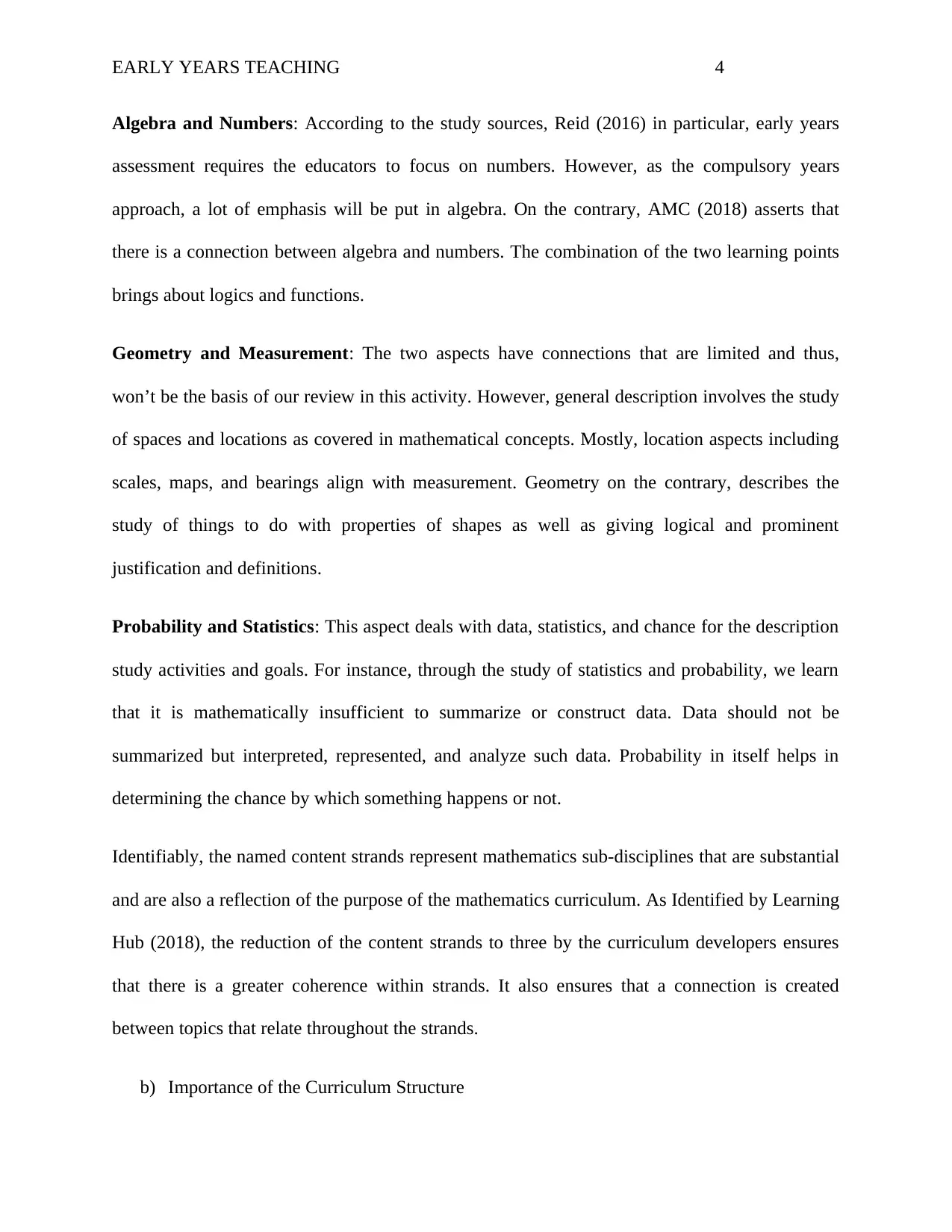
EARLY YEARS TEACHING 4
Algebra and Numbers: According to the study sources, Reid (2016) in particular, early years
assessment requires the educators to focus on numbers. However, as the compulsory years
approach, a lot of emphasis will be put in algebra. On the contrary, AMC (2018) asserts that
there is a connection between algebra and numbers. The combination of the two learning points
brings about logics and functions.
Geometry and Measurement: The two aspects have connections that are limited and thus,
won’t be the basis of our review in this activity. However, general description involves the study
of spaces and locations as covered in mathematical concepts. Mostly, location aspects including
scales, maps, and bearings align with measurement. Geometry on the contrary, describes the
study of things to do with properties of shapes as well as giving logical and prominent
justification and definitions.
Probability and Statistics: This aspect deals with data, statistics, and chance for the description
study activities and goals. For instance, through the study of statistics and probability, we learn
that it is mathematically insufficient to summarize or construct data. Data should not be
summarized but interpreted, represented, and analyze such data. Probability in itself helps in
determining the chance by which something happens or not.
Identifiably, the named content strands represent mathematics sub-disciplines that are substantial
and are also a reflection of the purpose of the mathematics curriculum. As Identified by Learning
Hub (2018), the reduction of the content strands to three by the curriculum developers ensures
that there is a greater coherence within strands. It also ensures that a connection is created
between topics that relate throughout the strands.
b) Importance of the Curriculum Structure
Algebra and Numbers: According to the study sources, Reid (2016) in particular, early years
assessment requires the educators to focus on numbers. However, as the compulsory years
approach, a lot of emphasis will be put in algebra. On the contrary, AMC (2018) asserts that
there is a connection between algebra and numbers. The combination of the two learning points
brings about logics and functions.
Geometry and Measurement: The two aspects have connections that are limited and thus,
won’t be the basis of our review in this activity. However, general description involves the study
of spaces and locations as covered in mathematical concepts. Mostly, location aspects including
scales, maps, and bearings align with measurement. Geometry on the contrary, describes the
study of things to do with properties of shapes as well as giving logical and prominent
justification and definitions.
Probability and Statistics: This aspect deals with data, statistics, and chance for the description
study activities and goals. For instance, through the study of statistics and probability, we learn
that it is mathematically insufficient to summarize or construct data. Data should not be
summarized but interpreted, represented, and analyze such data. Probability in itself helps in
determining the chance by which something happens or not.
Identifiably, the named content strands represent mathematics sub-disciplines that are substantial
and are also a reflection of the purpose of the mathematics curriculum. As Identified by Learning
Hub (2018), the reduction of the content strands to three by the curriculum developers ensures
that there is a greater coherence within strands. It also ensures that a connection is created
between topics that relate throughout the strands.
b) Importance of the Curriculum Structure
Paraphrase This Document
Need a fresh take? Get an instant paraphrase of this document with our AI Paraphraser
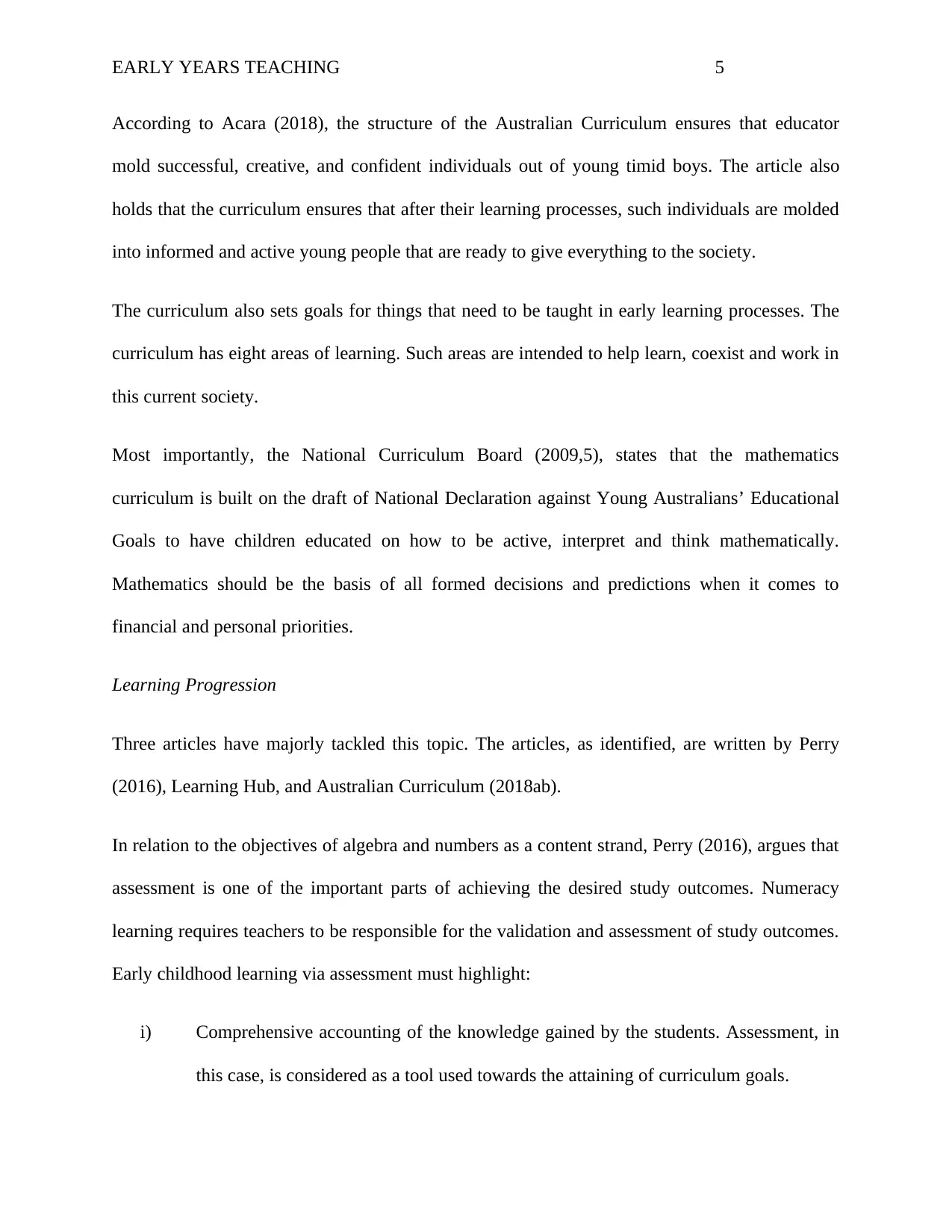
EARLY YEARS TEACHING 5
According to Acara (2018), the structure of the Australian Curriculum ensures that educator
mold successful, creative, and confident individuals out of young timid boys. The article also
holds that the curriculum ensures that after their learning processes, such individuals are molded
into informed and active young people that are ready to give everything to the society.
The curriculum also sets goals for things that need to be taught in early learning processes. The
curriculum has eight areas of learning. Such areas are intended to help learn, coexist and work in
this current society.
Most importantly, the National Curriculum Board (2009,5), states that the mathematics
curriculum is built on the draft of National Declaration against Young Australians’ Educational
Goals to have children educated on how to be active, interpret and think mathematically.
Mathematics should be the basis of all formed decisions and predictions when it comes to
financial and personal priorities.
Learning Progression
Three articles have majorly tackled this topic. The articles, as identified, are written by Perry
(2016), Learning Hub, and Australian Curriculum (2018ab).
In relation to the objectives of algebra and numbers as a content strand, Perry (2016), argues that
assessment is one of the important parts of achieving the desired study outcomes. Numeracy
learning requires teachers to be responsible for the validation and assessment of study outcomes.
Early childhood learning via assessment must highlight:
i) Comprehensive accounting of the knowledge gained by the students. Assessment, in
this case, is considered as a tool used towards the attaining of curriculum goals.
According to Acara (2018), the structure of the Australian Curriculum ensures that educator
mold successful, creative, and confident individuals out of young timid boys. The article also
holds that the curriculum ensures that after their learning processes, such individuals are molded
into informed and active young people that are ready to give everything to the society.
The curriculum also sets goals for things that need to be taught in early learning processes. The
curriculum has eight areas of learning. Such areas are intended to help learn, coexist and work in
this current society.
Most importantly, the National Curriculum Board (2009,5), states that the mathematics
curriculum is built on the draft of National Declaration against Young Australians’ Educational
Goals to have children educated on how to be active, interpret and think mathematically.
Mathematics should be the basis of all formed decisions and predictions when it comes to
financial and personal priorities.
Learning Progression
Three articles have majorly tackled this topic. The articles, as identified, are written by Perry
(2016), Learning Hub, and Australian Curriculum (2018ab).
In relation to the objectives of algebra and numbers as a content strand, Perry (2016), argues that
assessment is one of the important parts of achieving the desired study outcomes. Numeracy
learning requires teachers to be responsible for the validation and assessment of study outcomes.
Early childhood learning via assessment must highlight:
i) Comprehensive accounting of the knowledge gained by the students. Assessment, in
this case, is considered as a tool used towards the attaining of curriculum goals.
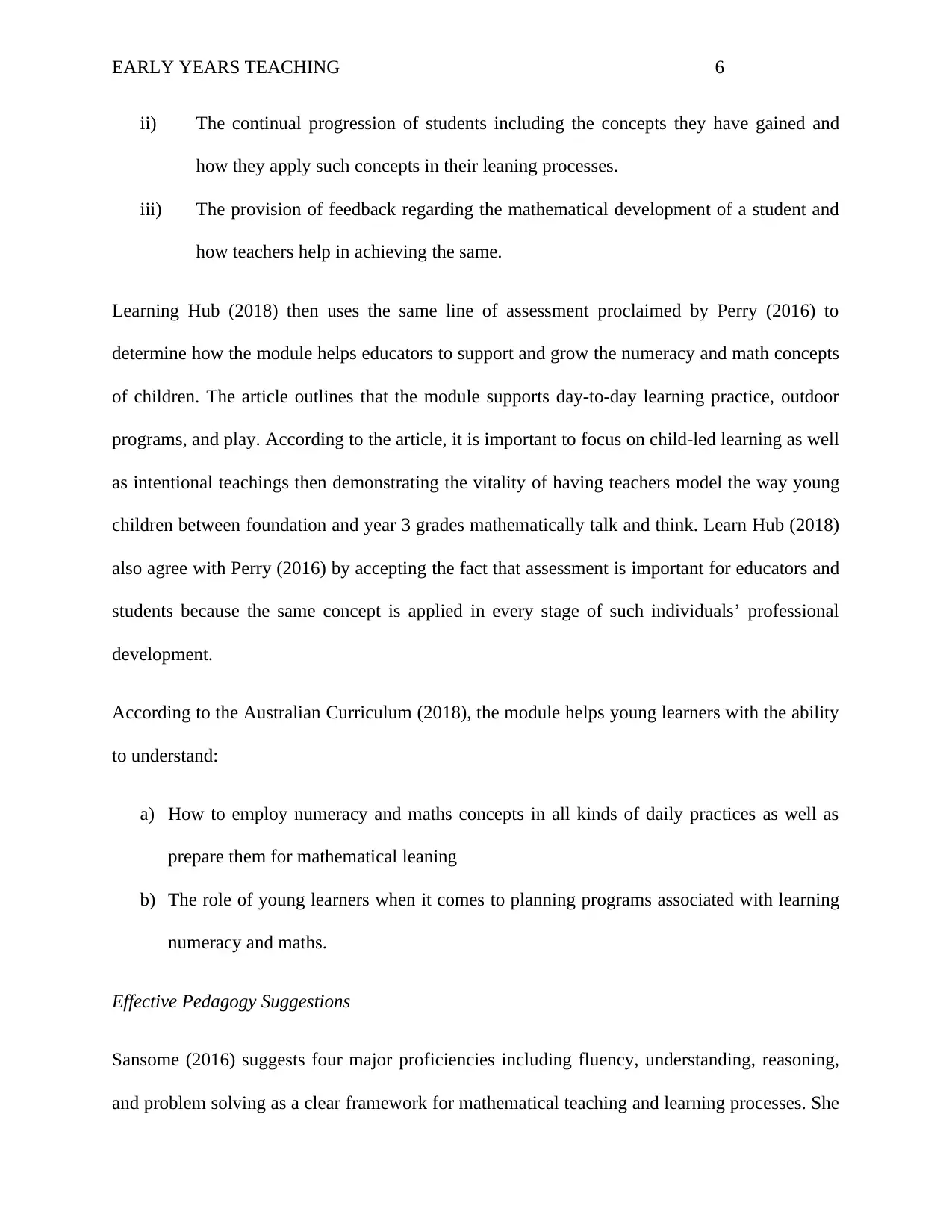
EARLY YEARS TEACHING 6
ii) The continual progression of students including the concepts they have gained and
how they apply such concepts in their leaning processes.
iii) The provision of feedback regarding the mathematical development of a student and
how teachers help in achieving the same.
Learning Hub (2018) then uses the same line of assessment proclaimed by Perry (2016) to
determine how the module helps educators to support and grow the numeracy and math concepts
of children. The article outlines that the module supports day-to-day learning practice, outdoor
programs, and play. According to the article, it is important to focus on child-led learning as well
as intentional teachings then demonstrating the vitality of having teachers model the way young
children between foundation and year 3 grades mathematically talk and think. Learn Hub (2018)
also agree with Perry (2016) by accepting the fact that assessment is important for educators and
students because the same concept is applied in every stage of such individuals’ professional
development.
According to the Australian Curriculum (2018), the module helps young learners with the ability
to understand:
a) How to employ numeracy and maths concepts in all kinds of daily practices as well as
prepare them for mathematical leaning
b) The role of young learners when it comes to planning programs associated with learning
numeracy and maths.
Effective Pedagogy Suggestions
Sansome (2016) suggests four major proficiencies including fluency, understanding, reasoning,
and problem solving as a clear framework for mathematical teaching and learning processes. She
ii) The continual progression of students including the concepts they have gained and
how they apply such concepts in their leaning processes.
iii) The provision of feedback regarding the mathematical development of a student and
how teachers help in achieving the same.
Learning Hub (2018) then uses the same line of assessment proclaimed by Perry (2016) to
determine how the module helps educators to support and grow the numeracy and math concepts
of children. The article outlines that the module supports day-to-day learning practice, outdoor
programs, and play. According to the article, it is important to focus on child-led learning as well
as intentional teachings then demonstrating the vitality of having teachers model the way young
children between foundation and year 3 grades mathematically talk and think. Learn Hub (2018)
also agree with Perry (2016) by accepting the fact that assessment is important for educators and
students because the same concept is applied in every stage of such individuals’ professional
development.
According to the Australian Curriculum (2018), the module helps young learners with the ability
to understand:
a) How to employ numeracy and maths concepts in all kinds of daily practices as well as
prepare them for mathematical leaning
b) The role of young learners when it comes to planning programs associated with learning
numeracy and maths.
Effective Pedagogy Suggestions
Sansome (2016) suggests four major proficiencies including fluency, understanding, reasoning,
and problem solving as a clear framework for mathematical teaching and learning processes. She
⊘ This is a preview!⊘
Do you want full access?
Subscribe today to unlock all pages.

Trusted by 1+ million students worldwide
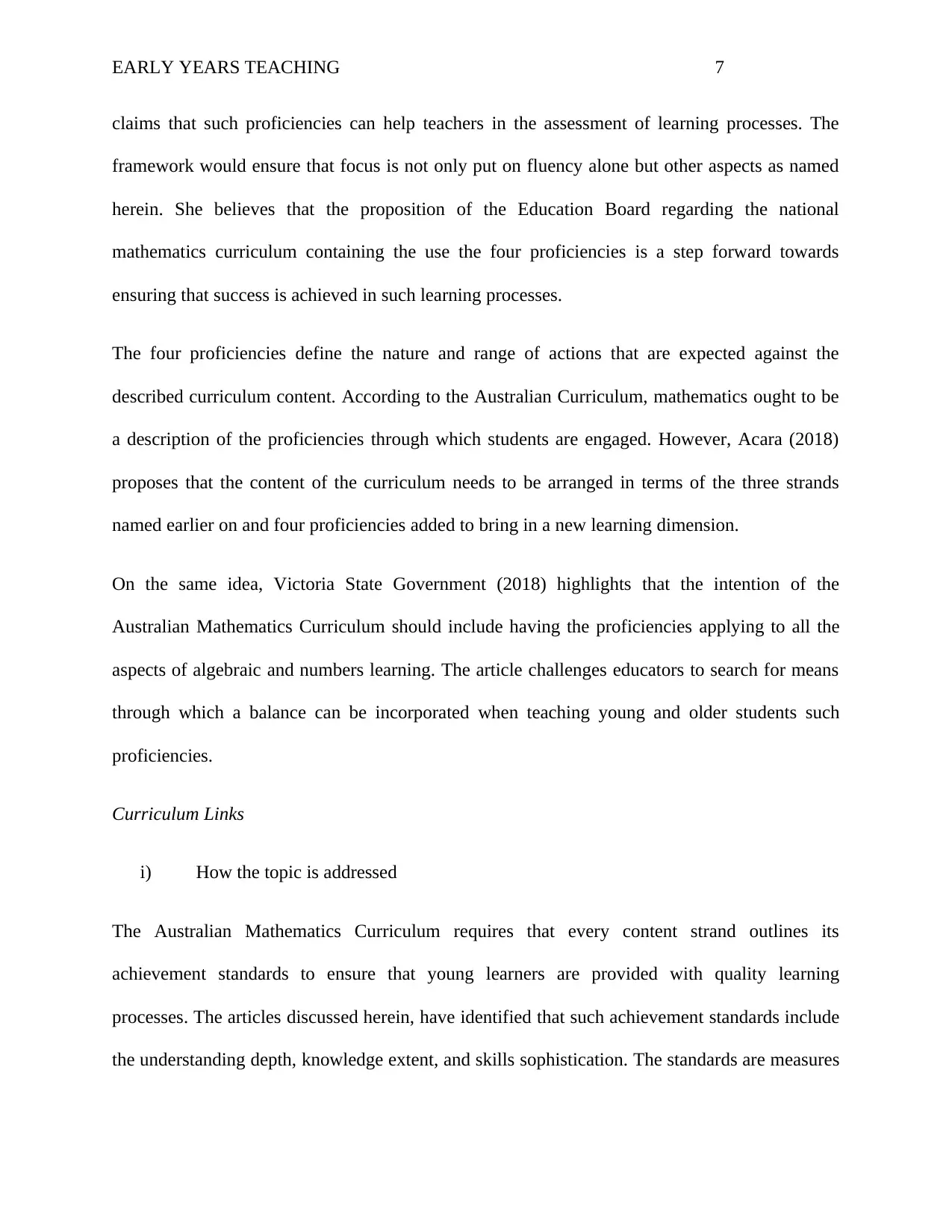
EARLY YEARS TEACHING 7
claims that such proficiencies can help teachers in the assessment of learning processes. The
framework would ensure that focus is not only put on fluency alone but other aspects as named
herein. She believes that the proposition of the Education Board regarding the national
mathematics curriculum containing the use the four proficiencies is a step forward towards
ensuring that success is achieved in such learning processes.
The four proficiencies define the nature and range of actions that are expected against the
described curriculum content. According to the Australian Curriculum, mathematics ought to be
a description of the proficiencies through which students are engaged. However, Acara (2018)
proposes that the content of the curriculum needs to be arranged in terms of the three strands
named earlier on and four proficiencies added to bring in a new learning dimension.
On the same idea, Victoria State Government (2018) highlights that the intention of the
Australian Mathematics Curriculum should include having the proficiencies applying to all the
aspects of algebraic and numbers learning. The article challenges educators to search for means
through which a balance can be incorporated when teaching young and older students such
proficiencies.
Curriculum Links
i) How the topic is addressed
The Australian Mathematics Curriculum requires that every content strand outlines its
achievement standards to ensure that young learners are provided with quality learning
processes. The articles discussed herein, have identified that such achievement standards include
the understanding depth, knowledge extent, and skills sophistication. The standards are measures
claims that such proficiencies can help teachers in the assessment of learning processes. The
framework would ensure that focus is not only put on fluency alone but other aspects as named
herein. She believes that the proposition of the Education Board regarding the national
mathematics curriculum containing the use the four proficiencies is a step forward towards
ensuring that success is achieved in such learning processes.
The four proficiencies define the nature and range of actions that are expected against the
described curriculum content. According to the Australian Curriculum, mathematics ought to be
a description of the proficiencies through which students are engaged. However, Acara (2018)
proposes that the content of the curriculum needs to be arranged in terms of the three strands
named earlier on and four proficiencies added to bring in a new learning dimension.
On the same idea, Victoria State Government (2018) highlights that the intention of the
Australian Mathematics Curriculum should include having the proficiencies applying to all the
aspects of algebraic and numbers learning. The article challenges educators to search for means
through which a balance can be incorporated when teaching young and older students such
proficiencies.
Curriculum Links
i) How the topic is addressed
The Australian Mathematics Curriculum requires that every content strand outlines its
achievement standards to ensure that young learners are provided with quality learning
processes. The articles discussed herein, have identified that such achievement standards include
the understanding depth, knowledge extent, and skills sophistication. The standards are measures
Paraphrase This Document
Need a fresh take? Get an instant paraphrase of this document with our AI Paraphraser
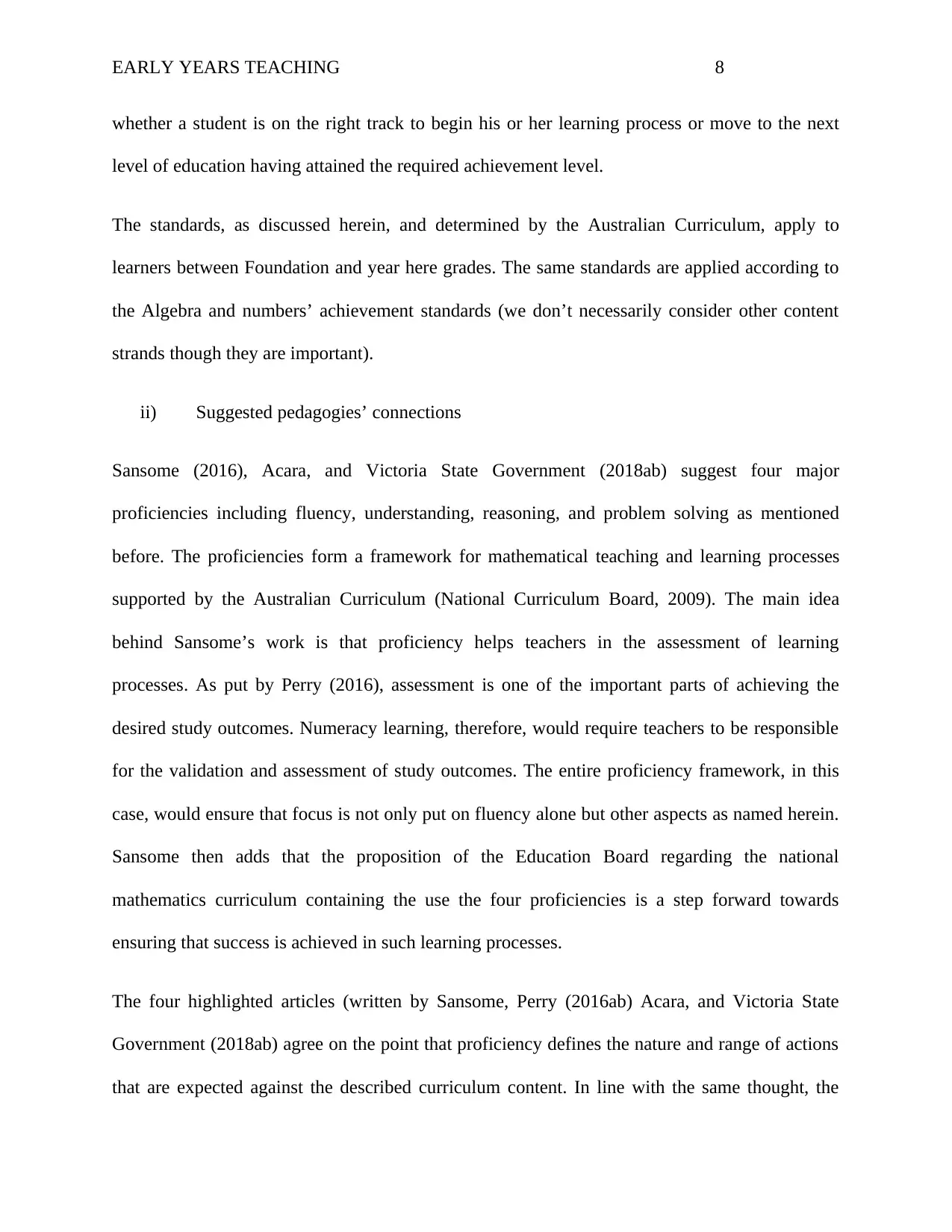
EARLY YEARS TEACHING 8
whether a student is on the right track to begin his or her learning process or move to the next
level of education having attained the required achievement level.
The standards, as discussed herein, and determined by the Australian Curriculum, apply to
learners between Foundation and year here grades. The same standards are applied according to
the Algebra and numbers’ achievement standards (we don’t necessarily consider other content
strands though they are important).
ii) Suggested pedagogies’ connections
Sansome (2016), Acara, and Victoria State Government (2018ab) suggest four major
proficiencies including fluency, understanding, reasoning, and problem solving as mentioned
before. The proficiencies form a framework for mathematical teaching and learning processes
supported by the Australian Curriculum (National Curriculum Board, 2009). The main idea
behind Sansome’s work is that proficiency helps teachers in the assessment of learning
processes. As put by Perry (2016), assessment is one of the important parts of achieving the
desired study outcomes. Numeracy learning, therefore, would require teachers to be responsible
for the validation and assessment of study outcomes. The entire proficiency framework, in this
case, would ensure that focus is not only put on fluency alone but other aspects as named herein.
Sansome then adds that the proposition of the Education Board regarding the national
mathematics curriculum containing the use the four proficiencies is a step forward towards
ensuring that success is achieved in such learning processes.
The four highlighted articles (written by Sansome, Perry (2016ab) Acara, and Victoria State
Government (2018ab) agree on the point that proficiency defines the nature and range of actions
that are expected against the described curriculum content. In line with the same thought, the
whether a student is on the right track to begin his or her learning process or move to the next
level of education having attained the required achievement level.
The standards, as discussed herein, and determined by the Australian Curriculum, apply to
learners between Foundation and year here grades. The same standards are applied according to
the Algebra and numbers’ achievement standards (we don’t necessarily consider other content
strands though they are important).
ii) Suggested pedagogies’ connections
Sansome (2016), Acara, and Victoria State Government (2018ab) suggest four major
proficiencies including fluency, understanding, reasoning, and problem solving as mentioned
before. The proficiencies form a framework for mathematical teaching and learning processes
supported by the Australian Curriculum (National Curriculum Board, 2009). The main idea
behind Sansome’s work is that proficiency helps teachers in the assessment of learning
processes. As put by Perry (2016), assessment is one of the important parts of achieving the
desired study outcomes. Numeracy learning, therefore, would require teachers to be responsible
for the validation and assessment of study outcomes. The entire proficiency framework, in this
case, would ensure that focus is not only put on fluency alone but other aspects as named herein.
Sansome then adds that the proposition of the Education Board regarding the national
mathematics curriculum containing the use the four proficiencies is a step forward towards
ensuring that success is achieved in such learning processes.
The four highlighted articles (written by Sansome, Perry (2016ab) Acara, and Victoria State
Government (2018ab) agree on the point that proficiency defines the nature and range of actions
that are expected against the described curriculum content. In line with the same thought, the

EARLY YEARS TEACHING 9
Australian Curriculum mentions that mathematics needs to be a description of the proficiencies
through which students are engaged (Victoria State Government, 2018). Finally, as Acara (2018)
proposes that the content of the curriculum needs to be arranged in terms of the three strands
named earlier on and four proficiencies (to bring in a new learning dimension), Victoria State
Government (2018) highlights that the intention of the Australian Mathematics Curriculum
should include employing the proficiencies to ensure that they apply to all the aspects of
algebraic and numbers learning.
3. CONCLUSION
This literature review activity identified six main articles talking of the orientation of children to
mathematical thinking. The identified articles also highlight a number of implications that the
Australian Curriculum imposes towards molding young Australians into better students in later
learning stages. The activity has identified ways through which the curriculum encourages
skillful thinking through the study of algebra and numbers. However, this activity has also
touched on other content strands in the field of mathematics. All the similarities and differences
regarding the flow of ideas in the used articles have been discussed in relation to the concepts
highlighted in the Australian Mathematics Curriculum.
Australian Curriculum mentions that mathematics needs to be a description of the proficiencies
through which students are engaged (Victoria State Government, 2018). Finally, as Acara (2018)
proposes that the content of the curriculum needs to be arranged in terms of the three strands
named earlier on and four proficiencies (to bring in a new learning dimension), Victoria State
Government (2018) highlights that the intention of the Australian Mathematics Curriculum
should include employing the proficiencies to ensure that they apply to all the aspects of
algebraic and numbers learning.
3. CONCLUSION
This literature review activity identified six main articles talking of the orientation of children to
mathematical thinking. The identified articles also highlight a number of implications that the
Australian Curriculum imposes towards molding young Australians into better students in later
learning stages. The activity has identified ways through which the curriculum encourages
skillful thinking through the study of algebra and numbers. However, this activity has also
touched on other content strands in the field of mathematics. All the similarities and differences
regarding the flow of ideas in the used articles have been discussed in relation to the concepts
highlighted in the Australian Mathematics Curriculum.
⊘ This is a preview!⊘
Do you want full access?
Subscribe today to unlock all pages.

Trusted by 1+ million students worldwide

EARLY YEARS TEACHING 10
Reference
Acara. (2018) THE AUSTRALIAN CURRICULUM – YEARS 1 AND 2. Australian
Curriculum. Retrieved 28 Aug 2018, from
http://docs.acara.edu.au/resources/Information_for_parents_years_1_-_2.pdf
AMC. (2018) Mathematics Challenge for Young Australians (MCYA). Australian Mathematics
Trust. Retrieved 28 Aug 2018, from https://www.amt.edu.au/mathematics/mcya/
Australian Curriculum. (2018) Understand How Mathematics Works. Mathematics. Retrieved 28
Aug 2018, from https://www.australiancurriculum.edu.au/f-10-curriculum/mathematics/?
year=11751&year=11752&year=11753&year=11754&strand=Number+and+Algebra&st
rand=Measurement+and+Geometry&strand=Statistics+and+Probability&capability=igno
re&capability=Literacy&capability=Numeracy&capability=Information+and+Communic
ation+Technology+(ICT)
+Capability&capability=Critical+and+Creative+Thinking&capability=Personal+and+Soc
ial+Capability&capability=Ethical+Understanding&capability=Intercultural+Understandi
ng&priority=ignore&priority=Aboriginal+and+Torres+Strait+Islander+Histories+and+C
ultures&priority=Asia+and+Australia
%u2019s+Engagement+with+Asia&priority=Sustainability&elaborations=true&elaborati
ons=false&scotterms=false&isFirstPageLoad=false&page=1
Learning Hub. (2018) MATHS IS EVERYWHERE. Early Childhood Australia. Retrieved 28
Aug 2018, from http://learninghub.earlychildhoodaustralia.org.au/elearning/maths-is-
everywhere/
National Curriculum Board (2009) Shape of the Australian Curriculum: Mathematics. Attorney-
General’s Department, 2(3), 3-13
Perry, B. (2016). Early Childhood Numeracy. University of Western Sydney, 45(4), 2-42.
Reid, K. (2016) Preschoolers and numeracy development. Teacher Insight. Retrieved 28 Aug
2018, from https://www.teachermagazine.com.au/articles/preschoolers-and-numeracy-
development
Sansome, J., E. (2016) Building teachers’ pedagogy practices in reasoning, to improve students’
dispositions towards mathematics. Office for Education Research Faculty of Education
Queensland University of Technology, 32(5), 4-195.
Victoria State Government. (2018). Number and Algebra. Mathematics. Retrieved 28 Aug 2018,
from https://www.education.vic.gov.au/school/teachers/teachingresources/discipline/
maths/continuum/Pages/continnumber.aspx
Reference
Acara. (2018) THE AUSTRALIAN CURRICULUM – YEARS 1 AND 2. Australian
Curriculum. Retrieved 28 Aug 2018, from
http://docs.acara.edu.au/resources/Information_for_parents_years_1_-_2.pdf
AMC. (2018) Mathematics Challenge for Young Australians (MCYA). Australian Mathematics
Trust. Retrieved 28 Aug 2018, from https://www.amt.edu.au/mathematics/mcya/
Australian Curriculum. (2018) Understand How Mathematics Works. Mathematics. Retrieved 28
Aug 2018, from https://www.australiancurriculum.edu.au/f-10-curriculum/mathematics/?
year=11751&year=11752&year=11753&year=11754&strand=Number+and+Algebra&st
rand=Measurement+and+Geometry&strand=Statistics+and+Probability&capability=igno
re&capability=Literacy&capability=Numeracy&capability=Information+and+Communic
ation+Technology+(ICT)
+Capability&capability=Critical+and+Creative+Thinking&capability=Personal+and+Soc
ial+Capability&capability=Ethical+Understanding&capability=Intercultural+Understandi
ng&priority=ignore&priority=Aboriginal+and+Torres+Strait+Islander+Histories+and+C
ultures&priority=Asia+and+Australia
%u2019s+Engagement+with+Asia&priority=Sustainability&elaborations=true&elaborati
ons=false&scotterms=false&isFirstPageLoad=false&page=1
Learning Hub. (2018) MATHS IS EVERYWHERE. Early Childhood Australia. Retrieved 28
Aug 2018, from http://learninghub.earlychildhoodaustralia.org.au/elearning/maths-is-
everywhere/
National Curriculum Board (2009) Shape of the Australian Curriculum: Mathematics. Attorney-
General’s Department, 2(3), 3-13
Perry, B. (2016). Early Childhood Numeracy. University of Western Sydney, 45(4), 2-42.
Reid, K. (2016) Preschoolers and numeracy development. Teacher Insight. Retrieved 28 Aug
2018, from https://www.teachermagazine.com.au/articles/preschoolers-and-numeracy-
development
Sansome, J., E. (2016) Building teachers’ pedagogy practices in reasoning, to improve students’
dispositions towards mathematics. Office for Education Research Faculty of Education
Queensland University of Technology, 32(5), 4-195.
Victoria State Government. (2018). Number and Algebra. Mathematics. Retrieved 28 Aug 2018,
from https://www.education.vic.gov.au/school/teachers/teachingresources/discipline/
maths/continuum/Pages/continnumber.aspx
Paraphrase This Document
Need a fresh take? Get an instant paraphrase of this document with our AI Paraphraser
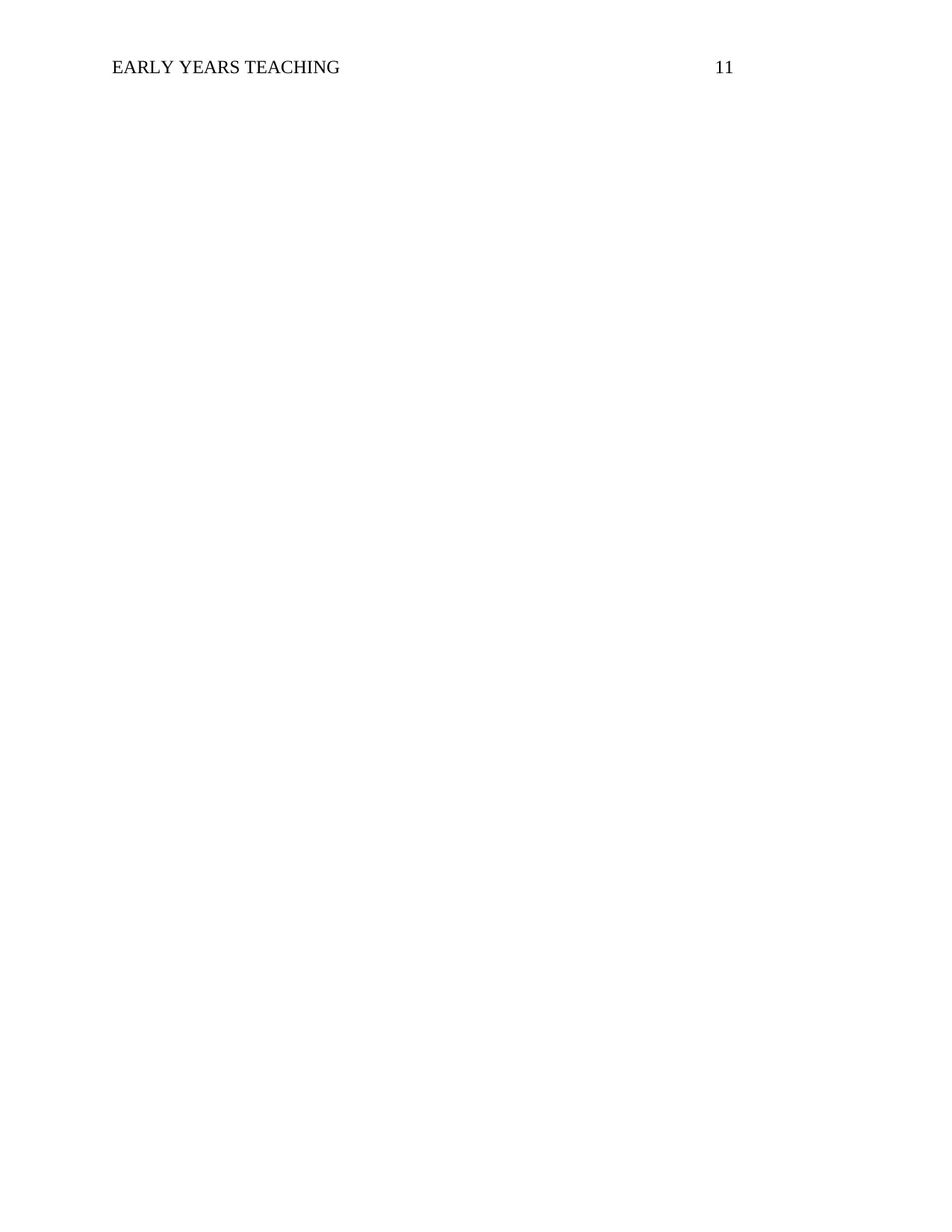
EARLY YEARS TEACHING 11
1 out of 11
Related Documents
Your All-in-One AI-Powered Toolkit for Academic Success.
+13062052269
info@desklib.com
Available 24*7 on WhatsApp / Email
![[object Object]](/_next/static/media/star-bottom.7253800d.svg)
Unlock your academic potential
© 2024 | Zucol Services PVT LTD | All rights reserved.




